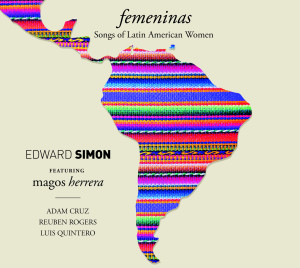 I first encountered the song “Gracias A La Vida” on the iconic album of the same name by Joan Baez, when one of my university Spanish teachers played it in class. It was my introduction to the sublime joys of the songs of Latin American women, and the album remains one of my favorites to this day. (I can’t believe I haven’t done a retrospective review of it, and may have to remedy that omission.) “Gracias” is the iconic song of the iconic Chilean composer, singer and activist Violeta Parra, one of the heroines of Latin American music in the 20th century.
I first encountered the song “Gracias A La Vida” on the iconic album of the same name by Joan Baez, when one of my university Spanish teachers played it in class. It was my introduction to the sublime joys of the songs of Latin American women, and the album remains one of my favorites to this day. (I can’t believe I haven’t done a retrospective review of it, and may have to remedy that omission.) “Gracias” is the iconic song of the iconic Chilean composer, singer and activist Violeta Parra, one of the heroines of Latin American music in the 20th century.
I first encountered the singing of Magos Herrera on Home Is Here by Brazilian American composer, bandleader and saxophonist Felipe Salles, which I reviewed earlier this year. The Mexico City native is now based in New York, where she sings, composes, records, teaches and is an integral part of the NYC and global jazz community.
Femeninas: Songs of Latin American Women was my introduction to Venezuelan pianist Edward Simon, and it’s an amazing introduction. On it, he and his trio (Adam Cruz on drums and Reuben Rogers on bass) team up with Herrera, Venezuelan percussionist Luis Quintero and Brazilian guitarist Romero Lubambo to celebrate songs by Latin American women songwriters including both long established artists and emerging ones. They include Parra of Chile, Marta Valdés (Cuba), Chabuca Granda (Perú), Elizabeth Morris (Chile), Rosa Passos (Brazil), Georgina Hassan (Argentina), and Joyce Moreno (Brazil).
Of course I went right to “Gracias a la Vida,” which is the fourth track, and her elegiac reading could hardly be more different than Baez’s upbeat anthemic march. She gives an impassioned first verse, rubato and a capella that gave me chills, which were only heightened when Simon entered, his piano playing a long downward, deeply minor-key chord sequence in 3/4. Rogers and Cruz join on bass and drums by the third verse, and then turn in an impassioned trio improvisation. Following one more emotional dive by Magos into the lyrics – Parra’s final verse in which she proclaims that her song is made of both laughter and grief and it is above all her own song, “mi propio canto” – the trio brings down the house with a thunderous coda.
Edward Simon’s trio and Magos Herrera have turned in what ought to be recognized as a unique and fabulous rendition of this beloved song. It’s different and challenging, but it captures the spirit of joy and grief that is so often the lot of women in Latin America and, really, everywhere in the world today. And that’s just one track of 11 on Femeninas.
And that’s just one track, although my favorite.
Edward Simon, a performer, composer, and arranger, has built his career since his first trio recording in 1994 on original compositions and “jazz informed” arrangements of pieces from the Great Latin American Songbook. His partnership with Herrera, who sings in Spanish, English, and Portuguese, and is deeply connected to the Latin American jazz scene past and present, and is a U.N. women’s spokesperson. This project is an outgrowth of a week’s residency by Simon and Herrera at the San Francisco Conservatory of Music. It includes a three-movement suite called “Latino Soy,” comprising “Naked Sky,” “Mujer Remolino,” and “Bulería,” supported by Chamber Music America’s New Jazz Works program.
I love diving into an album like this that presents an opportunity to learn about musicians who are new to me. In addition to Parra, they include the late Chabuca Granda of Peru, an early star of Latina music known for her melding of Creole waltzes with Afro-Peruvian polyrhythms, represented here by one of her hits “La Flor De La Canela.” This is such a great song – which would explain why it’s been recorded more than 600 times – and both Simon’s piano and Herrera’s husky vocals stand out.
Also notable are songs from two grande dames of Brazilian song, Rosa Passos, the 70-year-old jazz singer, songwriter and guitarist; and Joyce Moreno, 84, another Brazilian singer and guitarist. The album opens in style with Moreno’s “Feminina,” a fast paced samba that shows off the entire ensemble’s chops. Passos’ “Dunas” is a bit more lush and romantic but still highly danceable, and it moves Herrera into a slightly higher register. It’s rightly one of the most popular songs by Passos, whom some consider the queen of modern bossa nova and samba.
Of the three pieces in Latino Soy, the final “Bulería” is easily my favorite. It’s a pan-Latin style piece with Herrera’s occasional scat vocals floating over the ensemble’s challenging polyrhythms. This would be amazing to catch live. The whole date, though, is outstanding, and I haven’t even touched on the songs by contemporary Latinas. It’s available at the usual streaming and purchasing services.
(ArtistShare, 2023)
Edward Simon: Website | Instagram | Facebook | Twitter | Bandcamp | YouTube |
Magos Herrera: Website | YouTube | Facebook | Twitter | Instagram | Bandcamp|
(Herrera’s 2023 album Aire contains yet another interpretation of “Gracias A La Vida” in the style of the album’s chamber chamber jazz concept. It’s on her Bandcamp page.)
